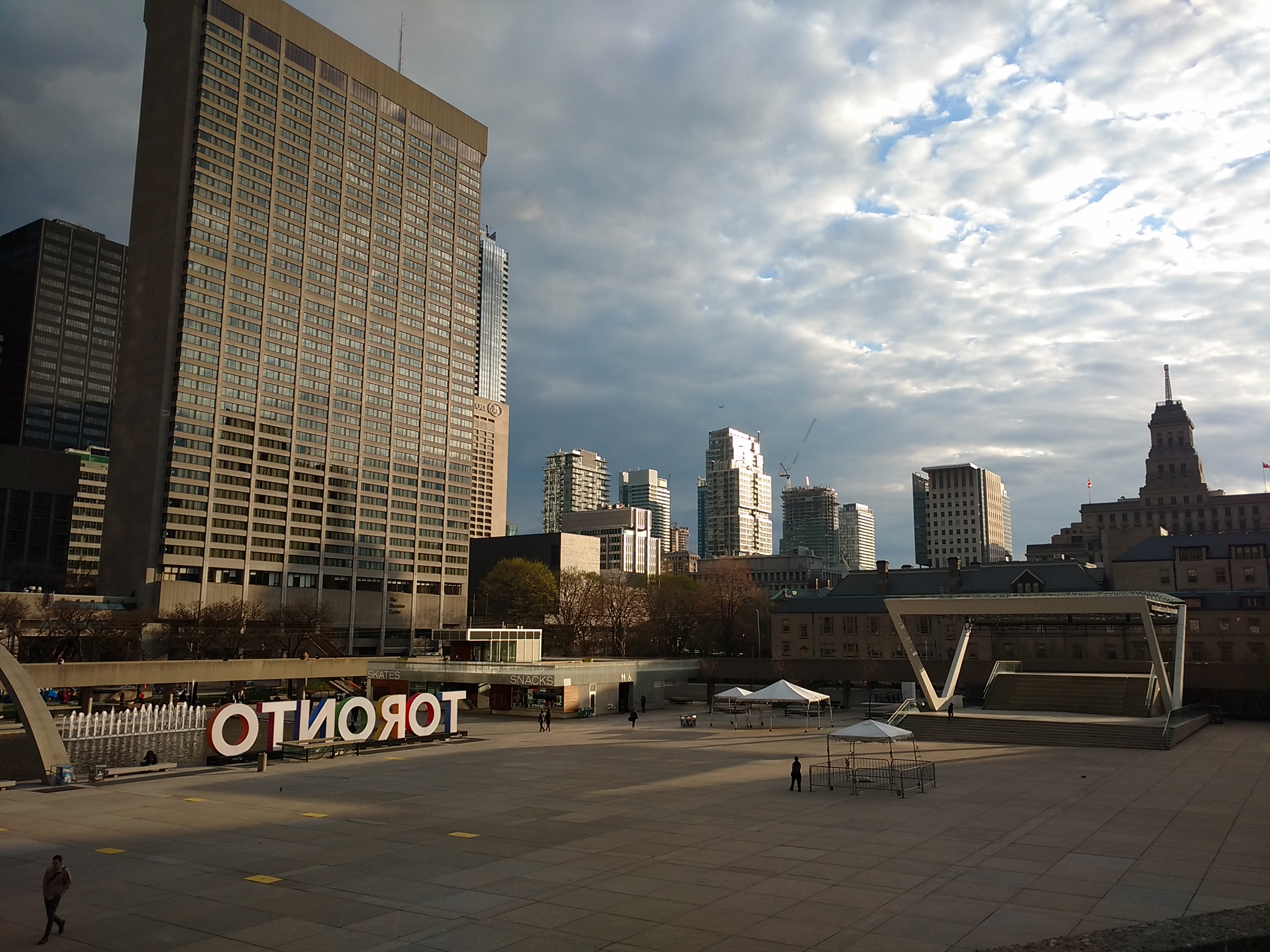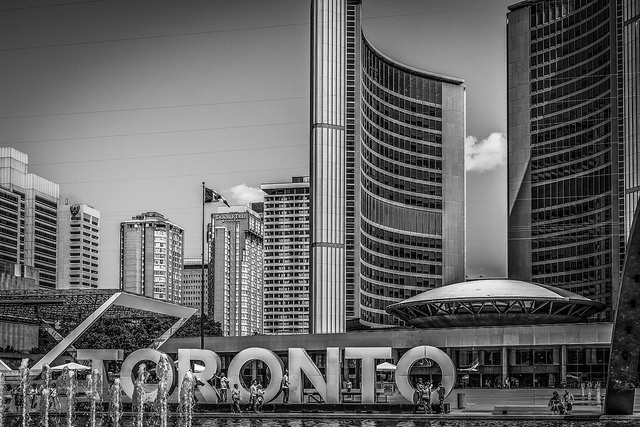Crossposted from Torontoist.
We read Council’s monthly agenda, so you don’t have to.
Photo by YihTang Yeo from the Torontoist Flickr pool.
Council returns from its summer break to a busy agenda. At this month’s meeting: Rail Deck Park, shelter NIMBYs, condo world problems, and more.
The Big Ticket
- The first step in the ambitious Rail Deck Park: creating a project team to strategize how to build and fund it. Staff now say it could cost over $1 billion, which sounds about right. Meanwhile, a group of developers are claiming they, not the rail companies, own the air rights to the proposed site, which will further complicate an already challenging project.
Gimme Shelter
- An interesting item comes from Mary-Margaret McMahon (Ward 32, Beaches-East York): City Council is still voting on where to put new shelters [PDF], though the OMB told them to stop doing it 12 years ago. What gives? (The response of the deputy city manager, who oversees Shelter, Support and Housing: the OMB found that requiring Council approval was inappropriate because it was redundant, not because it was discriminatory.) Here’s more historical background.
Related: strategies to fight NIMBY resistance; the latest on the emergency men’s shelter at 731 Runnymede. - The feds tossed Shelter, Support and Housing Administration some $3 million as part of the Homelessness Partnering Strategy. Sweet.
- We’ve previously covered how the Province has changed the Residential Tenancies Act to let domestic violence survivors break their leases safely. The Province is also giving the City $3 million for a new pilot project called the Portable Housing Benefit, which will provide financial assistance for domestic violence survivors on the social housing waitlist. It will be $500 per month, plus a one-time $2,500 “start-up” benefit upon getting a new place. Staff estimate the project will help 355 people.
Urban Planning
- This one’s for the serious nerds: updated setback requirements for tall buildings.
- City Planning prepares to begin consultations on putting limits on “big box” stores.
- The Integrity Commissioner attempts to head off councillors meddling with the Local Appeal Body, the board that will replace the OMB for Committee of Adjustment appeals.
- This motion from Michelle Holland (Ward 35, Scarborough Southwest) asks for detailed annual reports on Section 37 benefits. The thing is, Council already passed a motion that included a request for annual Section 37 reports (albeit not as detailed as Holland wants). City Planning produced one for 2013 and 2014…but there don’t seem to be any more. Did someone drop the ball here? Stay tuned.
Recreational Pursuits
- Did you know the average community centre is 40 years old? You would if you’d read the report on the Parks and Recreation Facilities Master Plan.
- The Tennis Permit Pilot Project will let residents and organizations pre-book tennis courts at four parks: Jonathan Ashbridge, Birchmount, Park Lawn, and Champlain Parkette. Don’t worry, they will still keep a court open for drop-in tennis playing.
Homes
- As condos take over Toronto, could their residents use extra support from the City? Shelley Carroll (Ward 33, Don Valley East) wants to emulate Chicago alderman Joe Moore’s condo workshops, which educate owners, tenants, and board members about governance issues. City staff: ¯\_(ツ)_/¯
- Down with glorified closets windowless bedrooms!
- The Friends of High Park Zoo are “looking to repair and upgrade key heritage structures to improve the quality of life of the animals…This includes the Zoo’s widely acclaimed peacock and capybara residents.”
- Local councillor Joe Cressy (Ward 20, Trinity-Spadina) wants an investigation into the recent CityPlace power outages.
- Surveillance state mired in red tape.
Exhibition Place and Environs
- Thanks to the efforts of Toronto’s Ukrainian-Canadian community, Exhibition Place is getting a memorial of the Holodomor, the famine, primarily a result of Soviet policies, that killed millions in Ukraine between 1932 and 1933.
- The quest to free the Greek gods from Muzik nightclub, postponed last meeting, continues.
- The latest giant billboard eyesore proposal: Strachan Avenue, just next to Fort York. Multiple previous violations, complaints from Liberty Village residents, twice as bright as permitted, would become third biggest in city, yadda yadda, you know the drill.
Getting Around
- The newest member of the public appointed to the TTC Board is high-powered finance and media executive Joanne de Laurentiis, who totally sounds like someone who takes the bus a lot.
- Cesar Palacio (Ward 17, Davenport) thinks street furniture and hydro poles are cluttering up the sidewalk. It would probably be easier to widen the sidewalk than move the poles. Just saying.
- Community groups in Weston and Mount Dennis are mobilizing for a greener alternative to a planned power plant that would be used as a backup power source for the Eglinton Crosstown.
- You know, we transit nerds scoff at some councillors’ proposals to dig subway tunnels a kilometre at a time, but that’s basically how the City is trying to build a bike lane network.
I Only Smoke When I Drink
- Frances Nunziata (Ward 11, York South-Weston) and Glenn De Baeremaeker (Ward 38, Scarborough Centre) want Municipal Licensing and Standards to start cracking down on hookah lounges and animal cruelty, respectively.
- Should licensed establishments be responsible for cleaning up cigarette butts around their premises?
- Most hipster liquor licence application objection this month: the new Parkdale outpost of temple to masculinity Rod, Gun & Barbers, where old-fashioned wet shaves come with bourbon and cigars.
Miscellaneous
- The City is taking steps to modernize its relationship with non-profits and community groups. As budget cuts continue forcing the City to “download” social services to the non-profit sector, having a formal policy framework in place is just a good idea.
- Raymond Cho, formerly representing Ward 42, Scarborough-Rouge River, has finally levelled up. Council must decide to fill the vacant seat through by-election or appointment.
Related: it seems like newbie Michael Ford (Ward 2, Etobicoke North) will get to be on the Government Management Committee. - Way back at amalgamation, Council decided that councillors’ staff who left their jobs and got severance packages couldn’t be re-hired by the City or other councillors for two years. This was meant to prevent “double-dipping”—receiving a severance while getting paid by the City at the same time. But times have changed, and now most councillors’ staff get nine months or less of severance. Thanks to the two-year rule, many people are ineligible for re-hiring for longer than they even worked for a councillor. This motion attempts to make things a bit more fair.
- Contract out all the things!! This time around, it’s Fleet Services.
- Obligatory technology buzzword members’ motion from Michelle Holland: smart roads. Our chief concern: what will we call a smart stroad? “Strmoad”?
Did we miss anything worth paying attention to? Let us know in the comments. And if you want to support more City Council coverage like this, chip in at Patreon. It makes a difference.
The post Toronto City Council Preview: October 2016 appeared first on Torontoist.




